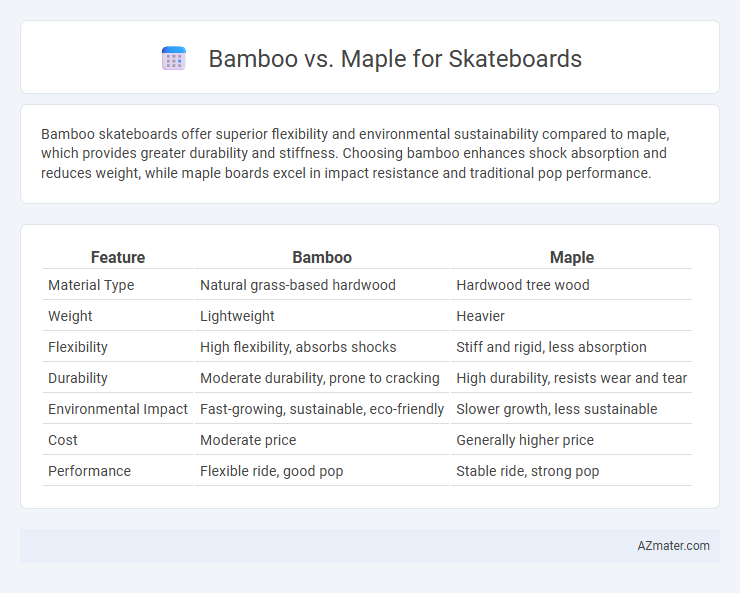Bamboo skateboards offer superior flexibility and environmental sustainability compared to maple, which provides greater durability and stiffness. Choosing bamboo enhances shock absorption and reduces weight, while maple boards excel in impact resistance and traditional pop performance.
Table of Comparison
| Feature | Bamboo | Maple |
|---|---|---|
| Material Type | Natural grass-based hardwood | Hardwood tree wood |
| Weight | Lightweight | Heavier |
| Flexibility | High flexibility, absorbs shocks | Stiff and rigid, less absorption |
| Durability | Moderate durability, prone to cracking | High durability, resists wear and tear |
| Environmental Impact | Fast-growing, sustainable, eco-friendly | Slower growth, less sustainable |
| Cost | Moderate price | Generally higher price |
| Performance | Flexible ride, good pop | Stable ride, strong pop |
Introduction: Bamboo vs Maple Skateboards
Bamboo skateboard decks are known for their flexibility, lightweight nature, and eco-friendly qualities, making them ideal for riders seeking a smoother ride and sustainability. Maple skateboards offer exceptional durability and strength due to their dense hardwood composition, providing excellent pop and control preferred by street skaters and professionals. Comparing bamboo and maple reveals distinct performance differences that cater to varied riding styles and environmental preferences.
Material Composition and Sourcing
Bamboo skateboards feature a natural fiber composition known for its flexibility, lightweight strength, and renewable sourcing from fast-growing bamboo stalks, making it an eco-friendly option. Maple skateboards are traditionally crafted from 7-ply hard maple wood, valued for its dense grain structure that provides durability and stiffness, sourced predominantly from North American hardwood forests. The difference in material composition affects performance characteristics, with bamboo offering enhanced shock absorption and maple delivering greater rigidity and impact resistance.
Strength and Durability Comparison
Bamboo skateboards offer exceptional flexibility and strength due to their natural fiber structure, providing resilience against impact and stress. Maple skateboards are renowned for their high density and hardness, delivering superior durability and resistance to wear from frequent use. When comparing durability, maple typically withstands heavy tricks and rough terrain longer, while bamboo provides enhanced shock absorption and a lighter overall board.
Flexibility and Performance
Bamboo skateboards offer exceptional flexibility due to their natural elasticity, allowing smoother carving and better shock absorption for enhanced performance in street and park skating. Maple decks, known for their rigidity and durability, provide superior pop and control, making them ideal for technical tricks and high-impact maneuvers. Choosing between bamboo and maple depends on whether the rider prioritizes responsive flex and comfort or precise control and longevity in their skateboard performance.
Weight Differences
Bamboo skateboards are significantly lighter than maple counterparts due to bamboo's natural density and flexibility, typically weighing around 2 to 3 pounds compared to maple's 3.5 to 5 pounds range. The reduced weight of bamboo boards enhances maneuverability and allows for quicker tricks and easier handling, appealing to skaters prioritizing agility. Maple decks offer greater durability and stiffness, but this often comes with added weight that can impact speed and control during complex skateboarding maneuvers.
Eco-Friendliness and Sustainability
Bamboo skateboards offer superior eco-friendliness due to bamboo's rapid growth rate and regenerative harvesting, making it a highly sustainable resource compared to maple, which requires decades to mature. Bamboo's natural flexibility enhances durability, reducing the need for frequent replacement and lowering environmental impact. Maple skateboards, although traditional and strong, involve slower tree replenishment and contribute to deforestation concerns, making bamboo a greener alternative for environmentally conscious riders.
Cost and Affordability Analysis
Bamboo skateboards generally offer greater affordability due to the material's rapid growth and renewability, resulting in lower production costs compared to maple. Maple skateboards, made from dense, hard rock maple wood, tend to be more expensive because of the labor-intensive harvesting process and higher durability. Consumers seeking budget-friendly options often prefer bamboo decks for their cost-efficiency without significantly compromising performance.
Ride Experience and Stability
Bamboo skateboards offer a flexible yet durable ride experience, absorbing shocks efficiently for smoother cruising and enhanced maneuverability. Maple decks are known for their rigidity and pop, providing superior stability and control during tricks and high-speed rides. Riders seeking a balance between flexibility and responsiveness often prefer bamboo, while those prioritizing precise stability and durability lean toward maple.
Popular Brands and Market Trends
Bamboo skateboards have gained popularity for their flexibility, durability, and eco-friendly properties, with brands like Loaded and Landyachtz leading the market. Maple skateboards remain a standard choice due to their stiffness and classic strength, with industry giants such as Element and Baker dominating sales. Market trends indicate a growing demand for hybrid boards combining bamboo and maple layers to optimize performance and sustainability.
Choosing the Right Material for Your Skateboard
Bamboo offers lightweight flexibility and exceptional strength, providing a smooth ride and increased pop for skateboarders seeking responsiveness. Maple, known for its durability and stiffness, delivers consistent performance and superior impact resistance, making it ideal for street and park skating. Choosing between bamboo and maple depends on riding style: bamboo suits riders prioritizing agility and eco-friendly materials, while maple benefits those needing robustness and traditional board stiffness.

Infographic: Bamboo vs Maple for Skateboard
 azmater.com
azmater.com